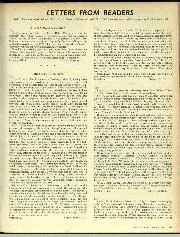
Another side of police
Sir, I read your letter, page 141 February issue, from Police Officer Harding. Accordingly, I make some comments below. Mr. P. G. Williams really has not much to complain about…
There’s always a tinge of compassionate sadness when one sees any long-time employee forced from a company after more than 20 years’ service. One feels right now for Mattia Binotto, having resigned – or been ‘invited’ to step down – from heading the Ferrari Formula 1 team at the end of this season past.
But temporary tenure has been the norm at Ferrari since pre-war times, with only a very few, such as the late Mauro Forghieri (admittedly in various roles), or that ferociously bright (and manipulative) little wizard Jean Todt, really lasting long.
When Enzo Ferrari first launched his co-operative Scuderia Ferrari venture in Modena through 1930 he largely ran the show himself. But as the Scuderia grew he engaged a local enthusiast – by some accounts his cousin – Mario Lolli to manage racing affairs.
Into 1932-33 with the Scuderia progressively becoming the Alfa Romeo works team by proxy, Lolli’s lack of foreign languages told. Consequently Mr Ferrari engaged Maestro Nello Ugolini, an immaculately-presented, suave gentleman, in his stead. Ugolini had risen to local prominence through the mid-1920s as deputy secretary to Mr Ferrari’s favourite football club, Modena. As the Scuderia Ferrari’s first properly-qualified sporting director, Ugolini shone and the operation under him ran pretty much like clockwork.
Ugolini had apparently earned the title Maestro from years as a schoolmaster, but from 1934-37 he was the Scuderia’s formal Direttore Sportivo. He proved his worth, not least when in 1936 on the team’s only foray to the US where Nuvolari won the George Vanderbilt Cup race for them, Ugolini talked the captain of the Italian liner Rex into delaying departure for three hours while he rushed back to the hotel to retrieve both the Cup, which Nuvolari had left behind, and the organiser’s prize money cheque for $86,000.
When Alfa Romeo took its racing operations back in-house for 1938-40, Ugolini joined Alfa Corse. Postwar he returned to football, managing Modena, whose president was Adolfo Orsi – industrialist owner of Maserati. Ugolini went on to manage Bologna, Fiorentina, Torino and Venezia footie clubs before, in 1952-56, rejoining Ferrari as DS.
For 1956, Orsi lured away Ugolini’s services to the Championship-winning Maserati team, after which – into the 1960s – the Maestro dexterously managed both the Venetian Count Volpi’s private Scuderia Serenissima racing team, and Venezia football club.
When Ferrari had first emerged as a racing marque in 1947, Mr Ferrari delegated DS duties to Federico Giberti, his long loyal engineering administrator. Into the ’50s Giberti progressively gave way in on-site technical race management to Mr Ferrari’s long-time friend, landowner and sparetime Ferraristo Girolamo ‘Mino’ Amorotti. He gave his time free of charge and often took advantage of that position by being one of very few who could tell Mr Ferrari to his face exactly what he thought. He would often declare “You don’t pay me, so you can’t fire me”. His lugubrious air and sleepy-spaniel eyebrows made him a distinctive figure within the Ferrari pits worldwide well into 1958. The drivers were not always quite sure what to make of this quiet, rather brooding man, but they came to respect and trust him.
“Nuvolari had left the Cup behind, and the organiser’s prize money”
Meanwhile, for 1956, formal team manager duties had been delegated by The Old Man to a well-known Italian sporting journalist, Eraldo Sculati. He blotted his copybook by failing to telephone Ferrari from the Argentine GP at the start of 1957, and he was summarily replaced by The Old Man’s not altogether willing PA, Romolo Tavoni, for 1957-61.
Tavoni became popular with the drivers, though given to outbursts if any of them did anything “that the boss would not like”. The best example of that was probably team driver Jean Behra losing his temper in the pits at Reims in 1959, taking a swing at engineer Luigi Bazzi but felling Tavoni instead. For Behra that was curtains. ‘Tavvy’ was finally fired in the sorry Ferrari ‘Palace Revolution’ ending 1961, whereupon Milanese cosmetics magnate – and head of the federation of Italian motor clubs team – Eugenio Dragoni was installed in his place. Dragoni famously fell out with Ferrari’s reigning World Champion Phil Hill during 1962, and later (most noisily) with John Surtees in 1966. For ’67 another Italian journalist, Franco Lini, used the Maranello revolving door, DS for one (tragic) year which saw Italy’s leading driver Lorenzo Bandini killed at Monaco and team-mate Michael Parkes maimed at Spa.
Through 1968-70, Mr Ferrari’s Tavoni-replacement PA, Dr Franco Gozzi, combined with Mauro Forghieri to run the team ‘in the field’ – while retired Swiss works driver Peter Schetty presided (most capably) 1971-72. Alessandro Colombo proved to be out of his depth in 1973 before Luca di Montezemolo emerged, formed that effective relationship with Niki Lauda, and the ship sailed well until 1975.
The ineffective Daniele Audetto (1976) was followed by superstitious Roberto Nosetto (wearing lucky green, 1977) – then the influential Marco Piccinini 1978-88, Cesare ‘Hollywood’ Fiorio 1989-91, Claudio Lombardi (1992), Jean Todt (1993-2007), before Stefano Domenicali (2008-14), Marco Matteucci (2014), Maurizio Arrivabene (2015-18) and Binotto since. Good times, tough times – what extraordinarily diverse and variably successful characters they have been.
Doug Nye is the UK’s leading motor racing historian and has been writing authoritatively about the sport since the 1960s